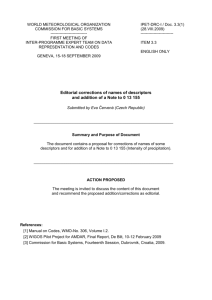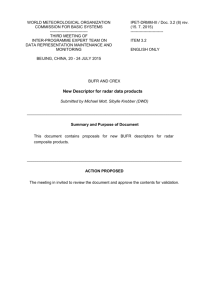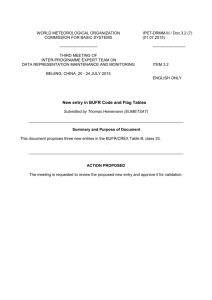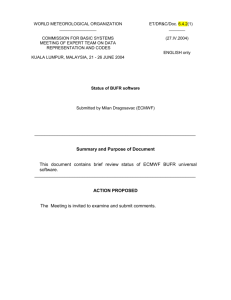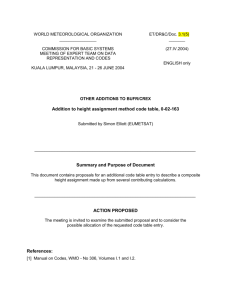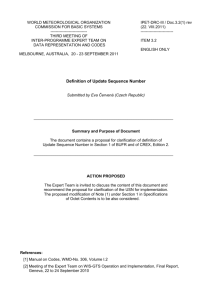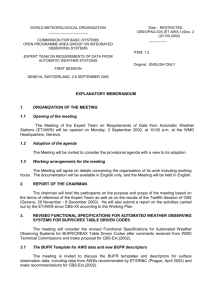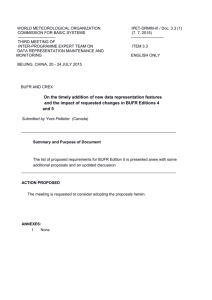Dissemination of global products from Metop Simon S. Elliott Introduction
advertisement
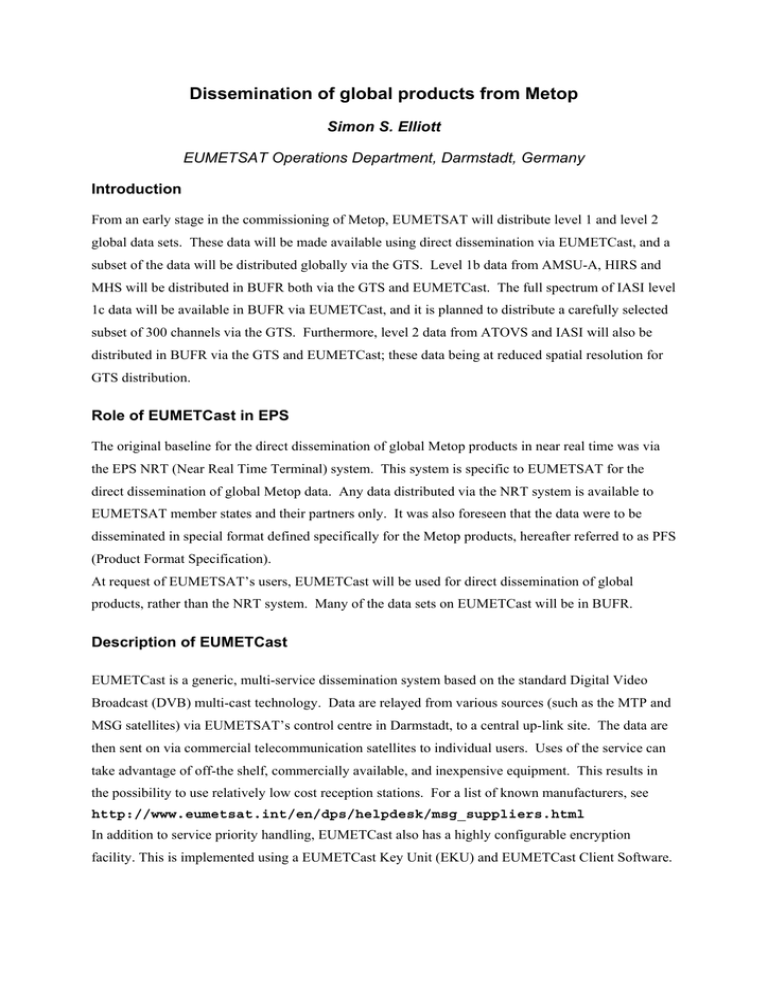
Dissemination of global products from Metop Simon S. Elliott EUMETSAT Operations Department, Darmstadt, Germany Introduction From an early stage in the commissioning of Metop, EUMETSAT will distribute level 1 and level 2 global data sets. These data will be made available using direct dissemination via EUMETCast, and a subset of the data will be distributed globally via the GTS. Level 1b data from AMSU-A, HIRS and MHS will be distributed in BUFR both via the GTS and EUMETCast. The full spectrum of IASI level 1c data will be available in BUFR via EUMETCast, and it is planned to distribute a carefully selected subset of 300 channels via the GTS. Furthermore, level 2 data from ATOVS and IASI will also be distributed in BUFR via the GTS and EUMETCast; these data being at reduced spatial resolution for GTS distribution. Role of EUMETCast in EPS The original baseline for the direct dissemination of global Metop products in near real time was via the EPS NRT (Near Real Time Terminal) system. This system is specific to EUMETSAT for the direct dissemination of global Metop data. Any data distributed via the NRT system is available to EUMETSAT member states and their partners only. It was also foreseen that the data were to be disseminated in special format defined specifically for the Metop products, hereafter referred to as PFS (Product Format Specification). At request of EUMETSAT’s users, EUMETCast will be used for direct dissemination of global products, rather than the NRT system. Many of the data sets on EUMETCast will be in BUFR. Description of EUMETCast EUMETCast is a generic, multi-service dissemination system based on the standard Digital Video Broadcast (DVB) multi-cast technology. Data are relayed from various sources (such as the MTP and MSG satellites) via EUMETSAT’s control centre in Darmstadt, to a central up-link site. The data are then sent on via commercial telecommunication satellites to individual users. Uses of the service can take advantage of off-the shelf, commercially available, and inexpensive equipment. This results in the possibility to use relatively low cost reception stations. For a list of known manufacturers, see http://www.eumetsat.int/en/dps/helpdesk/msg_suppliers.html In addition to service priority handling, EUMETCast also has a highly configurable encryption facility. This is implemented using a EUMETCast Key Unit (EKU) and EUMETCast Client Software. Availability of data sets Many of the global data sets from Metop will be in BUFR format. This decision was made because BUFR offers the potential to encode any type of data whilst remaining compliant with an international standard commonly used in numerical weather prediction. Level 1 data • ATOVS: As part of the EUMETSAT’s EARS service, level 1c data from the AMSU-A, AMSU-B and HIRS instruments on the NOAA spacecraft are being operationally disseminated in BUFR. For the sake of continuity, the corresponding level 1 products from Metop will also be encoded in BUFR. The MHS data will be encoded using the same sequence currently employed for AMSU-B. • AVHRR: The AVHRR level 1 data will be distributed in the format given by the EPS product format specification (PFS). • IASI: The IASI level 1c data will be encoded in BUFR. The planned template is described in the Annex to this document. • ASCAT: The ASCAT level 1 data will be distributed in parallel, encoded in BUFR and the format given by the EPS product format specification. • GRAS: The GRAS level 1 data will be distributed in parallel, encoded in BUFR and the format given by the EPS product format specification. • GOME: The GOME level 1 data will be distributed in the format given by the EPS product format specification. Level 2 data The baseline for the level 2 profile data from ATOVS and IASI will be encoding in BUFR. The full data set will be distributed via EUMETCast. GTS distribution The distribution of level 2 profile data from ATOVS and IASI on the GTS/RMDCN (Global Telecommunication Network/Regional Meteorological Data Communication Network) is part of the EPS baseline. The data are a subset of the full ATOVS and IASI level 2 data, and will be distributed via NRT/EUMETCast at a resolution compatible with the GTS/RMDCN link capacity. Although any type of data can be exchanged via the RMDCN, only data encoded in an appropriate format can be exchanged in the context of the GTS. Dissemination of IASI level 1c product in BUFR on the GTS is currently limited by the bandwidth of the GTS, but the dissemination of a significantly reduced data set is feasible using the BUFR template given in Annex 1. The actual definition of the content of a reduced size IASI level 1c product for GTS distribution is being based on a direct dialogue with the global user community. Part of this interaction took place at the 14th International TOVS Study Conference in Beijing, May 2005. As part of the EARS service, level 1c data from the AMSU-A, AMSU-B and HIRS instruments on the NOAA spacecraft are being distributed via the GTS/RMDCN. In a similar way to the EUMETCast dissemination, the corresponding level 1 products from Metop will also be encoded in BUFR and distributed via the GTS/RMDCN. The data distribution mechanisms and formats are summarized in the following table. AMSUA HIRS MHS ATOVS IASI ASCAT AVHRR GOME GRAS EUMETCast Level 1 Level 2 BUFR BUFR BUFR BUFR BUFR BUFR BUFR and PFS BUFR from SAF PFS PFS BUFR from SAF (TBC) BUFR and PFS BUFR from SAF (TBC) Level 1 BUFR BUFR BUFR BUFR BUFR - GTS Level 2 BUFR BUFR BUFR from SAF BUFR from SAF - BUFR from SAF Data grouping and compression The BUFR supports the compression of data within the format itself. The efficiency of the compression is best for large sets of self similar data. If data sets are too large, the variability of the data can make the compression less efficient. If data sets are too small, end effects such as headers and trailers can dominated the data volume. During the encoding of the Metop data global products, the data are grouped in order to (i) maintain some physical meaning to group, and (ii) make compression efficient. For IASI level 1c data, 1 scan line is used per BUFR message, and for the other level 1 data many complete scan lines per message. Prior to transmission, the messages grouped into files such that one file is used for each per PDU (Product Dissemination Unit) (3 minutes of data, also one granule). Internet resources Many tools and documents about BUFR are available from the internet. Some of the most useful ones are given here • Software for processing BUFR is widely available, for example via free download from ECMWF: http://www.ecmwf.int/products/data/software/bufr.html • BUFR tables can be downloaded from WMO: http://www.wmo.int/web/www/WMOCodes.html • A BUFR guide is available from WMO: http://www.wmo.int/web/www/WMOCodes/Guides/BUFRCREXPreface_en.html Annex - BUFR encoding template for IASI level 1c. In the encoding sequence shown below, 14 local descriptors have been used. These are shaded in grey. These descriptors have been used to simplify the encoding process. They will be defined in the co-ordinated BUFR tables as soon as possible. The information with indices 50 and 51 has been added since the ITSC XIV in order to give the relative position of the AVHRR cluster in the IASI field of view. index descriptor 0 0-01-007 1 0-01-031 2 0-02-019 3 0-02-020 4 0-04-001 5 0-04-002 6 0-04-003 7 0-04-004 8 0-04-005 9 2-02-131 10 2-01-138 11 0-04-006 12 2-01-000 13 2-02-000 14 0-05-001 15 0-06-001 16 0-07-024 17 0-05-021 18 0-07-025 19 0-05-022 20 0-05-043 21 0-05-040 22 2-01-133 23 0-05-041 24 2-01-000 25 2-01-132 26 0-25-070 27 28 29 30 31 32 33 34 35 36 37 2-01-000 2-02-126 0-07-001 2-02-000 0-33-192 0-33-193 0-33-194 0-33-195 0-33-196 0-33-197 1-03-010 38 39 0-25-192 0-25-193 description satellite id id of originating centre satellite instrument satellite classification year month day hour minute change scale +3 change width +10 second change width to default change scale to default latitude (high accuracy) longitude (high accuracy) Satellite zenith Satellite azimuth Solar zenith Solar azimuth Pixel number Orbit number change width +5 Scan line number change width to default change width +4 Frame count / granule number change width to default change scale -2 Height of station change scale to default GQisFlagQual QGisQualIndex QGisQualIndexLoc QGisQualIndexRad QGisQualIndexSpect GQisSysTecSondQual Repeat next 3 descriptors 10 times Start channel End channel value 3 254 221 61 missing missing meaning METOP1 EUMETSAT IASI EPS 40 41 0-25-194 1-05-087 42 1-04-100 43 44 45 46 47 48 2-01-136 0-05-042 2-01-000 0-14-192 0-02-019 0-25-051 49 1-09-007 50 0-05-192 51 0-05-193 52 0-25-085 53 1-05-006 54 55 56 57 58 0-05-042 0-25-194 0-14-193 0-25-194 0-14-194 Channel scale factor Repeat next 5 descriptors 87 times Repeat next 4 descriptors 100 times change width +8 Channel number change width to default Scaled radiance satellite instrument AVHRR channel combination Repeat next 9 descriptors 7 times Y angular position of centre of gravity Z angular position of centre of gravity Fractional coverage of AVHRR radiance cluster Repeat next 5 descriptors 6 times Channel number Channel scale factor Scaled mean radiance Channel scale factor Scaled standard deviation of radiance 591 AVHRR/3
